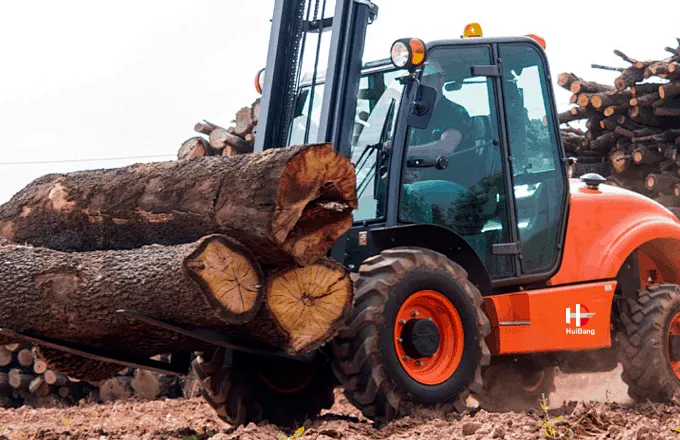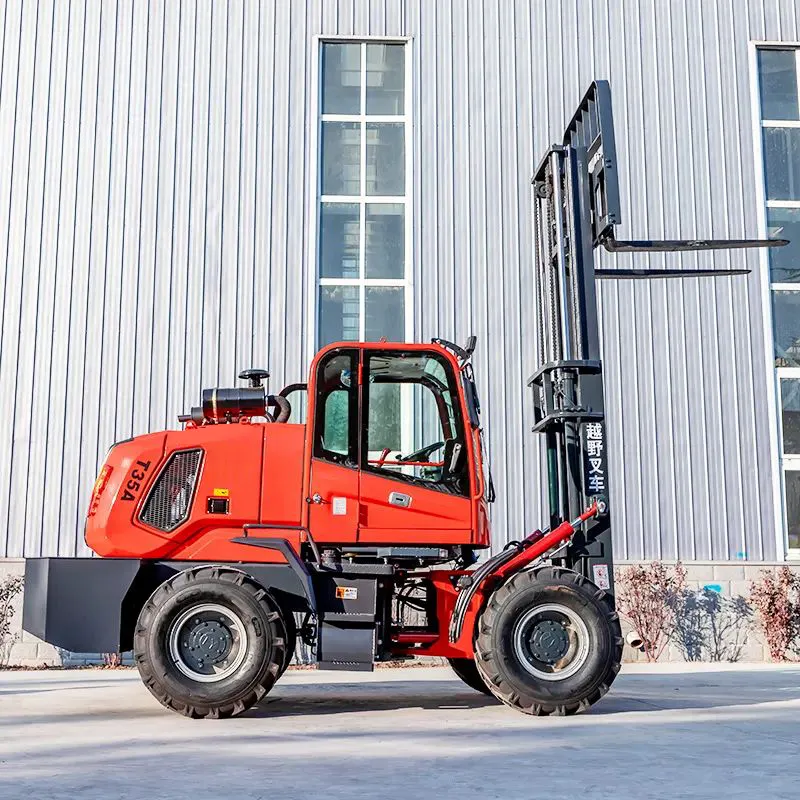Avoid your inquiry is delay response, please enter your WhatsApp/Skype along with the message, so we can contact you at the very first time.
We will reply you within 24 hours. If for urgent case, please add WhatsApp/WeChat: +86 188 0000 0000,. Or call 0086-535-2422021 directly.
*We respect your confidentiality and all information are protected. We will only use your information to respond to your inquiry and will never send unsolicited emails or promotional messages.
Mud, rocks, and steep slopes can stop a normal forklift. I have felt that pain on many jobs.

A rough terrain forklift is a heavy‑duty lift truck with large tires, high ground clearance, and strong engines that let me carry pallets and materials over soft, uneven, or debris‑covered ground.
This 5T rear-steering off-road forklift excels in tough environments with a robust drivetrain, adaptive power, and seamless load handling. Advanced anti-slip technology ensures stability at high speeds (up to 40 km/h), while heat-resistant components enhance durability. Its optimized hydraulic system and multi-stage transmission provide precise torque control for efficient lifting and transport.
The idea sounds simple, yet the details matter. I will show why this machine fits harsh sites and how its lifting power keeps projects on schedule.
Every outdoor job fights loose soil, gravel ruts, and sudden rain. Standard warehouse trucks sink or tip. That is the problem.
I use Huibang Rough Terrain Forklift to move bricks, lumber, feed, and pipes across construction zones, farms, lumber yards, and disaster areas where paved roads do not exist.
Why I love Huibang Rough Terrain Forklift so much is because it’s Equipped with automated gear-shifting and smart controls, this forklift reduces operator fatigue with intuitive handling and adaptive workflows. Autonomous driving modes and programmable settings streamline tasks, while energy-efficient mechanisms lower fuel consumption. Its ergonomic design, featuring low-pressure driving and shock absorption, ensures comfort during long shifts, making it ideal for high-intensity industrial applications.
I rely on this machine when I need speed and safety on wild ground. The list below shows the main tasks and the pain points it solves.
| Site Type | Common Loads | Pain Point Without RT Forklift | Result With RT Forklift |
|---|---|---|---|
| Building site | Bricks, steel beams, rebar | Wheel spin, stuck axles | Smooth travel |
| Farm or ranch | Hay bales, fertilizer bags | Deep ruts, soft soil | Steady traction |
| Lumber yard | Logs, plywood bundles | Loose bark, sawdust piles | Clean movement |
| Event setup | Stage gear, seating racks | Turf damage, tight deadlines | Fast placement |
| Relief mission | Food crates, water tanks | Rubble, broken roads | Quick aid delivery |
I have moved pallet after pallet of concrete blocks across half‑finished roads. The wide pneumatic tires float instead of digging trenches. The higher mast clears rebar clusters. That saves crane time and lets crews lay walls sooner.
When rain turns a paddock to clay, I still haul feed. The differential lock and torque converter keep wheels turning. I cut labor hours because workers no longer drag sacks by hand.
Logs roll and drop bark chips that clog small wheels. My rough terrain forklift1 handles the mess. Fork positioners grab uneven timber bundles, and I stack them tight for kiln drying.
Outdoor concerts need gear fast but must protect the grass. Low ground pressure tires reduce damage. I drive across fairgrounds, unload speakers, and leave no deep tracks.
After a storm, roads break. I bring generators and water pallets right to the shelter door. The machine’s sealed electrics and air intake above the hood keep it running in shallow floods.
These examples show why I keep one in my fleet. It turns chaos into order, day after day.

Lifting limits decide if a machine pays for itself. Overload, and you lose money and safety.
Most rough terrain forklifts lift 4,000 lb to 10,000 lb, while heavy models exceed 12,000 lb; actual capacity drops as you raise the mast or work on a slope.

The rated number on the data plate is only the start. I must check height charts, ground angles, and attachment weight before every lift.
| Machine Class | Base Capacity (lb) | Max Lift Height (ft) | Typical Engine HP |
|---|---|---|---|
| Compact RT | 4,000 – 5,500 | 15 | 50 – 60 |
| Mid‑size RT | 6,000 – 8,000 | 18 | 65 – 80 |
| Large RT | 9,000 – 12,000+ | 22 | 90 – 120 |
If I lift 8,000 lb at ground level, that same load may drop to 5,500 lb at full height. The center of gravity shifts, and the counterweight can only do so much. I read the load chart stuck on the cab door every morning.
A five‑degree side slope can cut safe capacity by 30 %. The mast tilts, and tires on the low side compress. I always square up to the hill or level the site with a blade first.
Side‑shift carriages, fork positioners, or drum clamps add steel ahead of the mast. That extra mass eats into payload. I subtract the attachment weight from the rated number before lifting cargo.
Underinflated tires flex and raise rolling resistance. Overinflated ones lose grip on rocks. I keep pressure in the sweet spot so the forklift pushes forward without bounce. Proper traction lets the machine reach its full hydraulic power.
A weak pump slows lift speed and reduces pressure, which lowers real capacity. I change filters and oil on schedule. A smooth hydraulic whine tells me the system can meet spec.
Sudden throttle or sharp turns shift weight and invite tip‑over. I coach my team to lift slow, lower the load for travel, and keep the mast tilted back. Good habits protect both men and metal.
I once lifted 9,000 lb steel beams with our 10,000 lb model on flat gravel. The forklift felt solid. Later, the same beams on a slight incline felt risky, so I split the load. That judgment call kept the project safe and on time.
Regular checks keep the rated numbers real. I inspect chains, carriage pins, and mast rollers weekly. I grease every fitting. When tires wear past 50 %, I replace them. These small costs stop big accidents.
A rough terrain forklift gives me the reach and muscle to move heavy loads where roads end, and it keeps doing so as long as I respect its limits and care for it.
You can also go to learn about Huibang Rough Terrain Forklift, trust me! It will surprise you.